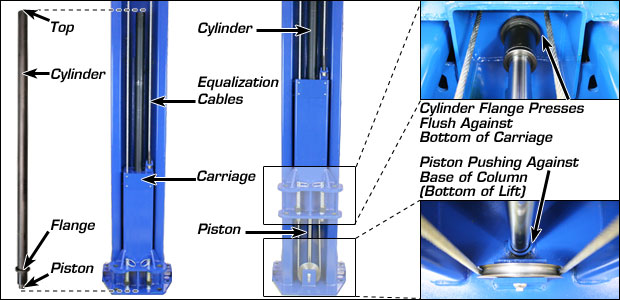
The "chain-over" cylinder lifting method is preferable for low ceiling applications because it uses a shorter cylinder to achieve maximum lifting height. A roller attached to the end of the piston exerts pressure on the chain. One end of the chain is fixed to the bottom of the column and the other end of the chain is attached to the carriage. When the piston roller raises 1 inch, the carriage lifts two inches. This is an effective way to maximize lifting height without the piston extending above the top of the column. The "chain-over" cylinder lifting method is less efficient than the direct drive cylinder configuration.


The direct drive hydraulic cylinder configuration is the preferred cylinder lifting system for commercial overhead two post above ground lifts. The direct drive cylinder configuration has fewer moving parts than the chain-over-roller cylinder configuration. In this direct drive configuration, it is actually the cylinder (attached to the carriage) that moves up; as the hollow piston rod exerts pressure on the base of the column.
The pressurized hydraulic fluid flows into the side of the cylinder rod (there is a metal cap on the end of rod) and moves up through the length of the hollow cylinder rod into the cylinder. The pressure of the hydraulic fluid (inside the cylinder) pushes against the top of the piston rod and the cylinder (attached to the carriage) travels up inside the column.
This is the process that raises the vehicle.
The pressurized hydraulic fluid in the cylinder cannot move "back down" through the hollow rod against the pressure of the hydraulic fluid moving "up". The top of the piston rod is slightly smaller than the inside of the honed cylinder. The piston head has one polyurethane sealing O'ring located in the center groove of the head, and two "positioning" synthetic seal guides located near the top and bottom the piston rod head.
The sealing O'ring prevents the cylinder's pressurized hydraulic fluid from "seeping around" the piston head. The two "positioning" seal guides prevent the metal piston head from contacting the honed cylinder walls during the travel sequence.
This direct drive system, with fewer moving parts, ensures years of excellent lifting service from your Atlas above ground hoist.